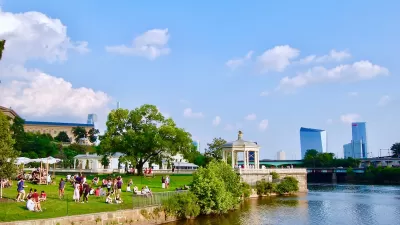A visit to the park highlights the creative reuse and design that is transforming an old railway into a vibrant public space.

Scott Pruden reports on the June opening of the first phase, an elevated quarter-mile stretch, of Philadelphia’s Rail Park. “When completed, the full Rail Park will have remade three miles of abandoned tracks, thoroughfares and tunnels that once allowed for the importation of raw materials like coal and steel and the export of goods produced in the city’s factories,” says Pruden.
While comparisons to New York’s High Line are inevitable, Rail Park will be twice as long when completed. The design also incorporates some very local features and references, including a map showing the location of old rail lines and buildings in the area as well as sheet metal and girder features.
Pruden says two of the most unique elements of the park are huge bench swings attached to steel beams and a mural by artist Shepard Fairey. He adds that the park has brought other amenities to the area, such as a beer garden, food carts, and eateries.
“The renovations for Phase One of the Rail Park now terminate abruptly just past the swings, with the untamed and overgrown portions of the viaduct plainly in view. But with this initial success, visitors can be sure more delights from this urban green space are on track,” adds Pruden.
FULL STORY: Philadelphia’s new Rail Park is the city’s answer to Manhattan’s High Line

Planetizen Federal Action Tracker
A weekly monitor of how Trump’s orders and actions are impacting planners and planning in America.

Maui's Vacation Rental Debate Turns Ugly
Verbal attacks, misinformation campaigns and fistfights plague a high-stakes debate to convert thousands of vacation rentals into long-term housing.

Restaurant Patios Were a Pandemic Win — Why Were They so Hard to Keep?
Social distancing requirements and changes in travel patterns prompted cities to pilot new uses for street and sidewalk space. Then it got complicated.

In California Battle of Housing vs. Environment, Housing Just Won
A new state law significantly limits the power of CEQA, an environmental review law that served as a powerful tool for blocking new development.

Boulder Eliminates Parking Minimums Citywide
Officials estimate the cost of building a single underground parking space at up to $100,000.

Orange County, Florida Adopts Largest US “Sprawl Repair” Code
The ‘Orange Code’ seeks to rectify decades of sprawl-inducing, car-oriented development.
Urban Design for Planners 1: Software Tools
This six-course series explores essential urban design concepts using open source software and equips planners with the tools they need to participate fully in the urban design process.
Planning for Universal Design
Learn the tools for implementing Universal Design in planning regulations.
Heyer Gruel & Associates PA
JM Goldson LLC
Custer County Colorado
City of Camden Redevelopment Agency
City of Astoria
Transportation Research & Education Center (TREC) at Portland State University
Jefferson Parish Government
Camden Redevelopment Agency
City of Claremont




























